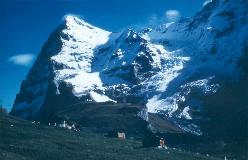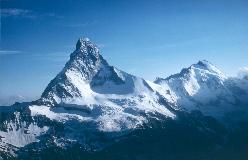|
Mountaineering in Switzerland
I have always been attracted to the mountains of Switzerland. No other place in Europe you will find such a concentration of
lofty, snowclad peaks, and such a variety of outstanding mountains. The Alps are not only covering most of Switzerland, but
also parts of the neighbouring countries France, Germany, Italy, Austria and Slovenia. But it is in Switzerland, you will
find the major multiplicy of great mountains: big singular massifs like the Grand Combin, long and rather uniform mountain
chains like in Grisons, wild and adventurous north faces like Eiger and the adjacing mountains facing Grindelwald, pointed
and dented ridges like the Nadelgrat, or unique and dominating mountains like Matterhorn.
In Switzerland you can always find a summit possible to climb, no matter the time of year or weather conditions, yet still
paying attention to the climber's experience, fitness, daring or need for challenge.
Although far the most of the Swiss mountains are parts of the Alps, it is possible to define several demarcated mountain
chains, each with its own character:
Jura
is a wide ridge of old limestone mountains, which borders to France between Basle and Geneva. The mountains are mostly
forested and are used for hiking in the summer and skiing (cross-country and alpine) in the winter. Where the rocks are
protruding from the soil, which happens in several places, there are often good possibilities of rockclimbing. The highest
point in Jura is Mont Tendre, 1679m.
Bernese Oberlands
is the northern foothills of the Northern limestone Alps, which south and east of Berne form a very popular hiking area,
with a lot of easy summits, offering very good views to the snowclad mountains further south. Bernese Oberlands have no
significant delimitation to the south, where the region is superseded by the Bernese Alps.
Bernese Alps
is the name of the mountain range, situated on the border between the states of Berne and Valais. The northern part of the
Bernese Alps is often referred to being a part of the Oberlands, whereas the southern part politically belong to Valais. In the
Bernese Alps we find the largest glaciated area of the Alps around the 25 km long Aletschgletscher, the longest glacier in
the Alps. The most dominant mountains in the Bernese Alps are the famous Jungfrau 4158m, Aletschhorn 4195, guarded
by glaciers on all sides, the Eiger 3970m with its notorious North Face, and Finsteraarhorn, at an altitude of 4274m the
heighest mountain of the range.


Pennine Alps
have the biggest concentration of high peaks in the Alps, as more than half of the summits above 4000m are found here in
Valais. The absolute center of mountaineering activities on these many summits is the Mattertal, with well-known villages
like Randa, Täsch and Zermatt, as from this valley you have access to no less than 31 4000-metre peaks, among these
Matterhorn 4478m, Monte Rosa 4634m and Dom 4545m. Another important valley is Saastal, which have many mountains in common with Mattertal plus a few
it keeps to itself. 13 4000-metre peaks can be reached from this valley, among these Nadelhorn 4327m and Weissmies 4023m.
Also worth mentioning is Val de Zinal in Anniviers, a more quiet valley, but still with access to one of the highest
mountains in the Alps: the beautiful Weisshorn 4505m, as well as four more 4000-metre peaks. The western summits in the
Pennine Alps may with advantage be reached from a base in the Rhône valley, from where it is easy to access the
different minor side valleys.
Uri
or the Urner Alps is a small, but well-defined mountain range between the Grimsel, Furka and Susten passes, yet quite
varied. The western part is made up by the large glaciated Winterberg massif, with several distinct summits up to 3630m,
whereas the eastern part offer some of the best rockclimbing in Switzerland, and perhaps even in the Alps as well.
Rockclimbing centers like Handegg, Göschenen and Eldorado are names well-known to any climber going for the harder
stuff, and since the region is not so visited by tourists in generel, you are likely to share the mountains with
like-minded people only.
Glarner Alps
is the mountain range between Vorderrhein in the south and Lake Zurich in north. The range is the eastern extension of Uri,
but the rock is not quite as good, and the number of visitors is smaller. The limestone rock is protruding in the northern
parts, and here several good crags are found, among these Brügglerwand, where the Danish Mountain Club for a period of
time has held its Alpine rockclimbing course.
Ticino
or the Tessiner Alps are squeezed between the two Rhine valleys and stretches towards Italy in the southernmost state in
Switzerland. The Tessiner Alps are rather low mountains, with Rheinwaldhorn 3402m as the highest peak. This part of
Switzerland is relative underdeveloped, and the mountain tourism is not so wide spread as further north. The range is a
typical hiking area with many easy yet still interesting summits, although the valley structures makes it a little
difficult to get around.
Grisons
or the Bündner Alps is a collective name of the vaste mountainous area stretching from the Rhine valley towards
Austria and Italy. This is the only Swiss section of the Eastern Alps, and the mountain chains are here interlocked through
each other; with the exception of the deep cut of the Inn valley there is no system found in the course of the valleys.
Like in Ticino there are here large areas with only few visitors, and it is also in Grisons, the only National Park in
Switzerland is found. On the other hand there are several places where the ski tourism is flourishing, as in St. Moritz,
Arosa, Davos and Klosters to mention a few. The central part of the mountains are mostly being used for hiking or easier
summit climbs, but in the south, near the village of Vicosoprano, the youngest granite of the Alps is found, forming
terrific climbing peaks like Piz Cengalo and Badile. And further east follows the Bernina group with the only 4000-metre
peak in the Eastern Alps: Piz Badile with an altitude of 4049m.
|






 Mountaineering in Valais (Danish language only)
Mountaineering in Valais (Danish language only)
 Facts about Switzerland (Danish language only)
Facts about Switzerland (Danish language only)
 Alpine 4000'ers
Alpine 4000'ers
 My own ascents
My own ascents
 Swiss Tourist Board
Swiss Tourist Board
 Swiss Alpine Club
Swiss Alpine Club
 SLF - Avalanche- and snow information Switzerland
SLF - Avalanche- and snow information Switzerland
 Danish Mountain Club
Danish Mountain Club